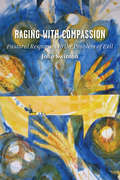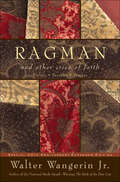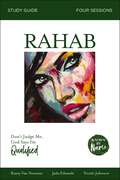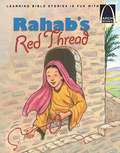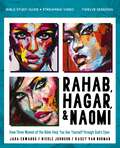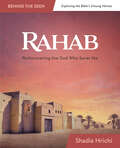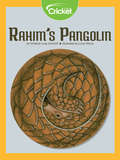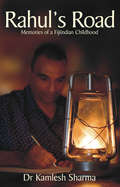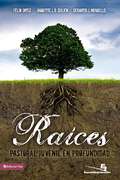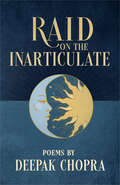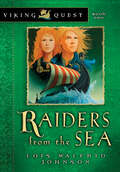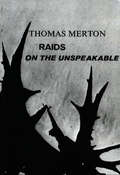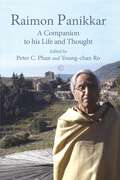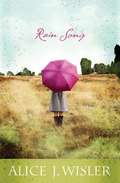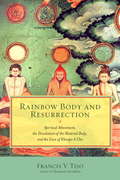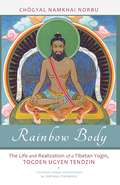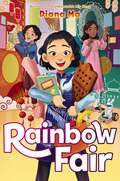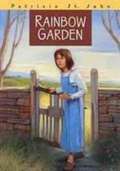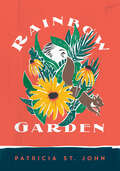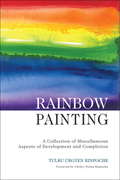- Table View
- List View
Raging with Compassion: Pastoral Responses to the Problem of Evil
by John SwintonCan we defend God's love, goodness, and power in a world scarred by violence and suffering? Do we need to? Traditional attempts to explain the problem of evil have mostly seen it as a philosophical and theological task. In this book John Swinton reminds readers that the experience of evil and suffering precedes pontification on its origin. Raging with Compassion seeks to inspire fresh Christian responses and modes of practice in our broken, fallen world.
Ragman: And Other Cries of Faith
by Walter Wangerin Jr.The expanded Twentieth Anniversary edition of stories, parables, and prayers from the National Book Award-winning author of The Book of the Dun Cow.Updated with eleven new stories and meditations, this Gold Medallion-winning classic interweaves vivid stories, deep meditations, and provocative allegories that together explore the power and meaning of love within an often inhumane urban landscape. The opening chapter, “Ragman,” remains one of Walter Wangerin Jr.’s most beloved works and leads the reader to thirty-three other writings, all bearing the author’s trademark poignancy and lyricism. Ranging from gentle reflections to heartrending invocations, these selections are powerful, thought-provoking explorations of the meaning of faith, the person of Christ, and the communion of believers. Again and again, Wangerin’s cries of faith touch our deepest pains with rays of joyful healing.“This diverse, polished collection . . . attests not only to Wangerin’s skill as a writer, but to the earnestness and warmth with which he enacts his vocation as a ‘servant of faith.’” —Christianity Today“This is a book of stories, stories of all sorts—of fear and pride and death and pain and forgiveness and laughter and tears and hope and many shades of glory.” —Robert McAfee Brown, author of Unexpected News
Rahab Bible Study Guide: Don’t Judge Me; God Says I’m Qualified (Known by Name)
by Nicole Johnson Jada Edwards Kasey Van NormanThe women in the Bible asked the same three questions we all still ask today: How does everyone else see me? How do I see myself? How does God see me?The Known By Name Bible study series for women—taught by seasoned Bible teachers Jada Edwards, Kasey Van Norman, and Nicole Johnson—will take you and your group through the lives of biblical women to learn more about God and how to answer these essential questions.Rahab's story, found in the book of Joshua, is a story of a girl boss, an assertive, confident woman who did what she had to do to provide for her family. Her identity was shaped by her upbringing. With no Bible study to join or podcast to download, Rahab learned her beliefs and behaviors in a culture that believed in gods, not God. But when opportunity knocked, she boldly trusted in the God she had never known, and became something she never imagined—a woman who brought freedom to generations.Follow Rahab in this 4-session Bible study (DVD/video streaming sold separately) as she trusts God's final word about her worth above society's words. You will learn how to shed unhelpful labels and fears, and instead revel in God's unconditional love and acceptance of you–just as you are. You can be free from shame and doubt.This study guide features video notes, group discussion questions, and between-session activities like reflecting on the drama and teachings, studying the character story in Scripture, memory verses, and journaling.Sessions include:Your Past Has a PurposeLiking Your ReflectionWhat&’s in a ReputationYou Have a Choice Designed for use with Known By Name: Rahab Video Study (9780310096344), sold separately.
Rahab's Red Thread
by Eric RottmannWith easy-to-read text and catchy rhymes, the author tells the story of Rahab--a story found in the Old Testament: Joshua, chapter 2. Reading level: grade 3. Interest level: ages 5-9. Other Arch books are available in this library.
Rahab, Hagar, and Naomi Bible Study Guide plus Streaming Video, Updated Edition: How Three Women of the Bible Help You See Yourself through God's Eyes
by Nicole Johnson Jada Edwards Kasey Van NormanHow does everyone else see me? • How do I see myself? • How does God see me?These women in the Bible asked the same three questions we still ask today. In this 12-session video study (video access included), you'll see how the stories of Rahab, Hagar, and Naomi reflect our own lives and what we can learn about ourselves from them.Throughout this study, these women step out of the pages of Scripture to walk with you through your own story with three powerful teaching methods:Live action dramatic interpretations that invite you into the biblical stories in a unique way.Bible teaching from a trusted pastor or Bible teacher.Character relations and reflection with a licensed Christian counselor and therapist. This study guide has everything you need for a full Bible study experience, including:The study guide itself—with discussion and personal reflection questions, video notes, character trait studies, and group discussion questions and prompts.An individual access code to stream all twelve video sessions online.This is an invitation to see how God's story includes you. Let Rahab, Hagar, and Naomi guide you to a stronger, more personal relationship with Him. Streaming video access included. Access code subject to expiration after 12/31/2030. Code may be redeemed only by the recipient of this package. Code may not be transferred or sold separately from this package. Internet connection required. Eligible only on retail purchases inside the United States. Void where prohibited, taxed, or restricted by law. Additional offer details inside.
Rahab: Rediscovering the God Who Saves Me
by Shadia HrichiStep into the story of Rahab, a woman who witnessed no miracles and knew none of God’s laws. She merely heard of God’s power—and believed.The story of Rahab appears after God commissions Joshua to lead the Israelites after the death of Moses. No sooner do the people come to the edge of the Promised Land than God puts the whole drama on hold to tell us the story of a Canaanite prostitute. This interruption of the conquest story gives us our first glimpse into the theological significance of Rahab’s story.In the New Testament, Rahab holds a surprisingly prominent position in several key faith passages—as well as being listed in the lineage of Christ! In fact, she marries a prince! The prostitute marries a prince! This is the stuff of movies. The heartbeat of the Bible is God’s passionate pursuit of his adulterous Bride—a theme that echoes within the depths of every human heart.But the best part? Rahab’s story is our story. It’s a story centered on three key themes, without which there would be no Bible, no gospel, and no Savior: faith, grace, and salvation. Through her daring faith, Rahab hid enemy spies, defied her king, risked her life, and found the living God. By the time you finish this six-week study, you will never look at the story of Rahab the same way again.
Rahel Varnhagen: The Life of a Jewish Woman
by Hannah Arendt Clara Winston Richard WinstonRahel Varnhagen (1777-1833) lived during the crucial period of assimilation in Germany, when it seemed imperative for Jews to escape their Jewishness.
Rahim's Pangolin
by Phillis GershatorRahim loves animals, but he’s forced to help his grandfather poach pangolins. He does not want to hunt these animals, but he also wants to “be a man” like his grandfather. When he comes across a mother pangolin and her baby in the forest, he must make a decision—stay true to his beliefs or make his grandfather proud.
Rahul’s Road: Memories of a Fijiindian Childhood
by Dr Kamlesh SharmaRahul's Road is a story of childhood in a Fijiindian village, Korovuto in Nadi on the largest island of the Fijian archipelago in the South Pacific. It presents a rich tapestry of the details of what it was like to grow up in a poor Fijiindian family. It captures moments of growing-up in Fiji with vividness and sensitivity. Written with feeling, the author's language has a simplicity that is quite remarkable in its richness and associations. The story told is complex, moving and vividly narrated. Rahul's Road will echo in the mind and memory of many Fijiindians within and outside their place of birth. It is a book for children, adolescents, adults who care about Fiji and the struggles and strengths of a migrant community. It cuts across barriers and builds bridges of memory, remembrance and understanding.
Raices: Pastoral Juvenil en Profundidad (Especialidades Juveniles)
by Annette Gulick Gerardo Miniello Felix OrtizSPANISH EDITION: This material uses Jesus as a model, concentrating on processes instead of events.
Raid on the Inarticulate
by Deepak ChopraA book of poems by bestselling author Deepak Chopra that are deeply spiritual, heartfelt, and touch on topics like God, love, surrender, shadow, and peace.Poetry is the language of the soul, according to Deepak Chopra, and in RAID ON THE INARTICULATE, he shares a collection of poems that, in his words, can very elegantly show us the truth of paradox and ambiguity. Poetry can be a source of awakening and revelation, and the poems in this book focus on conundrums, existential dilemmas, and consciousness; they're about love, peace, the timelessness of the mind, freedom, surrender, God, and the journey to the self.
Raiders from the Sea (Viking Quest Series #1)
by Lois Walfrid JohnsonIn one harrowing day, Viking raiders capture Bree and her brother Devin and take them from their home in Ireland. After the young Viking prince Mikkel sets Devin free on the Irish coast far from home, Bree and Devin embark on separate journeys to courage. Readers will be captivated by the unfolding drama as Bree sails to Norway on the Viking ship and Devin travels the dangerous road home. They both must trust their all-powerful God in the midst of difficult situations.
Raiders from the Sea (Viking Quest Series #1)
by Lois Walfrid JohnsonIn one harrowing day, Viking raiders capture Bree and her brother Devin and take them from their home in Ireland. After the young Viking prince Mikkel sets Devin free on the Irish coast far from home, Bree and Devin embark on separate journeys to courage. Readers will be captivated by the unfolding drama as Bree sails to Norway on the Viking ship and Devin travels the dangerous road home. They both must trust their all-powerful God in the midst of difficult situations.
Raids on the Unspeakable
by Thomas MertonThis collection of his prose writings reveals the extent to which Thomas Merton moved from the other-worldly devotion of his earlier work to a direct, deeply engaged, often militant concern with the critical situation of man in the world. Here this concern finds expression in poetic irony and in meditations intentionally dour. In these brief, challenging pieces, Father Merton does not offer consolation or easy remedies. He looks candidly and without illusions at the world of his time. Though he sees dark horizons, his ultimate answer is one of Christian hope. To vary the perspective, he writes in many forms, using parable and myth, the essay and the meditation, satire and manifesto, prose poetry and even adaptations from a medieval Arab mystic (Ibn Abbad) to humanize and dramatic his philosophical themes. The themes of Raids on the Unspeakable are as old as the myths of Prometheus and Atlas, and as timely as the human evils of today. They range from the "Message" written for an international congress of poets to the beautiful yet disturbing Christmas meditation, "The Time of the End Is the Time of No Room." And there are essays inspired by the world of three significant contemporary writers: Flannery O'Connor, the French novelist Julien Green, and the playwright Eugene Ionesco. A number of Father Merton's own drawings are also included in the book--not as "illustrations," but as "signatures" or :"abstract writings," which stand in their own right as another personal statement.
Raimon Panikkar: A Companion to his Life and Thought
by Peter C. Phan Young-Chan RoRaimon Panikkar: A Companion to his Life and Thought is a guide to the life, work and thought of Raimon Panikkar, a self-professed Buddhist-Christian-Hindu philosopher and theologian. A man of deep and wide learning and an extremely prolific author, Panikkar is equally at home in various religious and cultural traditions and embodies in himself the ideals of intercultural, intrareligious, and interreligious dialogues. This book explicates Panikkar's basic vision of life as the harmonious rhythm of divinity, humanity, and the cosmos, which he terms cosmotheandrism, and shows how it permeates and illumines his articulations of the central Christian doctrines. Given the complexity and difficulty of Panikkar's thought this book is a welcome companion for a course on Panikkar and for a general reader who wishes to understand one of the most profound and orginal thinkers of our time.
Rain Song (Heart of Carolina #1)
by Alice J. Wisler[From the back cover:] "His words have unlocked a special place in her heart, but he lives in the one place she vowed she'd never return... NICOLE MICHELIN avoids airplanes, motorcycles, and most of all, Japan, where her parents once were missionaries. Something happened in Japan. Something that sent Nicole and her father back to America alone. Something of which Nicole knows only bits and pieces. But she is content with life in little Mount Olive, North Carolina, with her quirky relatives, tank of lively fish, and plenty of homemade pineapple chutney. Through her online column for the Pretty Fishy website, Nicole meets Harrison Michaels, who, much to her dismay, lives in Japan. She attempts to avoid him, but his e-mails tug at her heart. Then Harrison reveals that he knew her as a child in Japan. In fact, he knows more about her childhood than she does! Will Nicole face her fears in order to discover her past and take a chance on love?" A recipe for Pineapple Chutney and book group discussion questions follow the text.
Rainbow Body and Resurrection
by Francis V. TisoFrancis V. Tiso, a noted authority on the rainbow body, explores this manifestation of spiritual realization in a wide-ranging and deeply informed study of the transformation of the material body into a body of light. Seeking evidence on the boundary between physical science and deep spirituality that might elucidate the resurrection of Jesus, he investigates the case of Khenpo A Chö, a Buddhist monk who died in eastern Tibet in 1999. Rainbow Body and Resurrection chronicles the dissolution of Khenpo's material body within a week of his death, including eye-witness interviews. Tiso describes the spiritual practices that give rise to the rainbow body and traces their history deep into the encounter of religions in medieval Central Asia. His erudite exploration of the Tibetan phenomenon raises the fascinating question of whether there is a connection between the rainbow body and the dying and rising of Jesus. Drawing on a wealth of recent research, Tiso expands his discussion to include the contemplative geography out of which Dzogchen arose some time in the eighth century along the great Silk Road across Central Asia. The result is an illuminating consideration of previously unimagined relationships between spiritual practices and beliefs in Central Asia.From the Trade Paperback edition.
Rainbow Body: The Life and Realization of a Tibetan Yogin, Togden Ugyen Tendzin
by Chogyal Namkhai Norbu Andriano ClementeAn inspiring biography of a twentieth-century Tibetan yogin, The Rainbow Body: The Life and Realization of a Tibetan Yogin, Togden Ugyen Tendzin, presents the remarkable life story of Togden (a title meaning "endowed with realization") Ugyen Tendzin (1888-1962) who, at the end of his life, attained the "rainbow body." Described as the release of the physical body to the essence of the five elements leaving no material body after death, the rainbow body has been achieved by advanced Tibetan masters in the Dzogchen tradition. It is believed that the rainbow body is an immaterial body, invisible to the physical eye, that continues to exists, actively working for the benefit of all sentient beings.Tendzin's nephew, author and Tibetan teacher, Chögyal Namkhai Norbu, developed the book from extensive interviews with Tendzin and information received from one of his closest disciples. Written mainly in first person, as if Tendzin himself were retelling the events of his life, the book traces his childhood struggles and the circumstances which led him to his teacher Adzom Drugpa Drodul Pawo Dorje, one of the greatest Dzogchen masters of the last century. Describing the lessons and instructions Tendzin received from his master, the book ends with a powerful account of Tendzin's final days in 1962 when he was imprisoned by Chinese revolutionaries. Imprisoned in a small barn, he continued to practice the bodily movements, and breathing and mental concentration exercises his master had taught him, until his physical body "dissolved" into the rainbow body.From the Trade Paperback edition.
Rainbow Cottage (Grace Livingston Hill #16)
by Grace Livingston HillSheila's life had never been so happy: the charming house by the ocean, the protection of a loving grandmother, the friendship of a strong and handsome man. It was so easy to enjoy the present and forget about the horrors of the past. But terror was about to close in on Sheila again. Grace Livingston Hill creates thrilling stories of inspiring, wholesome people whose ardent faith and overflowing hearts cope triumphantly with the problems of the world. Here are just a few books by Grace Livingston Hill in the Bookshare library: #18 Brentwood, #19 Daphne Deane, #22 Rose Galbraith, #24 By way of the silverthorns, #26 The Seventh Hour, #30 Matched Pearls, #33 Happiness Hill, #36 Patricia, #38 Spice Box, #41 blue ruin, #42 A New Name, #47 The Street of the City and #50 The Finding of Jasper Holt.
Rainbow Fair
by Diana MaSet against the backdrop of a middle school cultural fair, this tenderhearted and funny novel from the author of The Unbeatable Lily Hong stars twelve-year-old Sophie Mu—who discovers the power of defining oneself as she navigates friendship drama, family expectations, and learning about her Hui, her Chinese Muslim identity. Sophie’s work on the Chinese booth at last year’s Rainbow Fair is a point of pride for her and her parents, even if Sophie and her best friend, Katie, think the whole thing is a little silly. Sophie's family is Hui, Chinese Muslim. The Muslim part is something she doesn't know much about. Her parents prefer to keep it private. So when it gets slipped to an overenthusiastic teacher that Sophie is Muslim, the only Muslim in her class, suddenly Sophie is in charge of debuting a booth representing the Islamic religion she doesn't practice, an assignment she is determined to keep secret from her parents.Having to choose between leaving the Chinese booth or taking on double the workload leaves Sophie feeling conflicted. Why does she have to choose which part of herself to represent? Is it an issue with her or with how the Rainbow Fair is organized?Between juggling both booths, old and new friends, and learning more about her Muslim faith and ancestry, Sophie starts to notice how her working on two booths starts to spark change throughout the student body. It turns out Sophie isn't the only one at Monroe Middle School whose identity isn't so simply categorized by the Rainbow Fair's limited booths.One thing is for sure, this year's Rainbow Fair won't look anything like it did in the past, and Sophie begins to realize that that might not be a bad thing at all.
Rainbow Garden
by Patricia M. St. John Mary MillsWhen Elaine leaves her home in London to stay with the Owen family in Wales, she feels miserable and left out. It's only the little secret garden that she finds at the end of the rainbow that makes staying there seem worthwhile. And then something happens that changes everything.
Rainbow Garden: Elaine's Search For Joy (Patricia St John Series)
by Patricia St. JohnWhen Elaine leaves her home in London to stay with the Owen family in Wales, she feels miserable and left out. It's only the little secret garden that she finds at the end of the rainbow that makes staying there seem worthwhile. And then something happens that changes everything.
Rainbow Garden: Elaine's Search For Joy (Patricia St John Series)
by Patricia St. JohnWhen Elaine leaves her home in London to stay with the Owen family in Wales, she feels miserable and left out. It's only the little secret garden that she finds at the end of the rainbow that makes staying there seem worthwhile. And then something happens that changes everything.
Rainbow Painting
by Erik Pema Kunsang Marcia Binder Schmidt Tulku Urgyen Rinpoche Kerry MoranRainbow Painting is saturated with direct, pithy instruction, the very quintessence of the Buddhist Spiritual approach. Tulku Urgyen Rinpoche speaks from experience, expressing what he himself has undergone, instructing us in the way we should train in a complete and unmistaken manner. We come to understand that to become enlightened we must experience what was always present within us. The ultimate object of realization, the natural state of mind, unmistakenly and exactly as it is, need not be sought for elsewhere but is present within ourselves. Stability in this unexcelled state of unity is not attained independently of means, proper conduct and knowledge of the view. We should unite view and conduct; and this book contains the key points for doing just that."Some people have the habit of thinking that something is bound to happen after practicing meditation a while - like going through school - that after ten or fifteen years you end up with a degree. That's the idea in the back of people's minds: "I can make it happen! I can do enlight¬enment!" Not in this case, though. You cannot make enlightenment, because enlightenment is unconstructed. Realizing the awakened state is a matter of being diligent in allowing nondual awareness to regain its natural stability. It is difficult to reach enlightenment without such dili¬gence, without undertaking any hardship."---Tulku Urgyen Rinpoche"Tulku Urgyen Rinpoche is someone who has lived at length in mountain hermitages, spent many years in retreat, and done a considerable amount of meditation training. For this reason, he gives the very quintessence of the sacred Dharma spoken by our compassionate Buddha Shakyamuni. He speaks from experience, expressing what he himself has undergone, instructing us in the way we should practice in a complete and unmistaken manner. These teachings, saturated with direct, pithy instruction, are unique."---Chökyi Nyima RinpocheThe ultimate object of realization, the natural state of mind, unmistakenly and exactly as it is, need not be sought elsewhere than in ourselves. We become enlightened through experiencing what is always innately present. Stability in this unexcelled unawareness is attained when view, the knowledge aspect and conduct, the means are integrated. In Rainbow Painting, Tulku Urgyen Rinpoche presents the practices to accomplish this unity.
Rainbow Painting: A Collection of Miscellaneous Aspects of Development and Completion
by Erik Pema Kunsang Tulku Urgyen Chokyi NyimaSaturated with direct, pithy instructions, Rainbow Painting presents the very quintessence of the Buddhist Spiritual approach through the authentic personal experience of one of the greatest living meditation masters.Tulku Urgyen Rinpoche expresses what he himself has undergone, instructing us in a complete manner of training. To attain enlightenment we must experience our innate nature. The ultimate object of realization, the natural state of mind, unmistakenly and exactly as it is, need not be sought for elsewhere but is present within ourselves. Stability in this unexcelled state of unity is not achieved by separating what we know from what we do.This book contains astute instructions that address these key points of spirituality.From the Trade Paperback edition.
